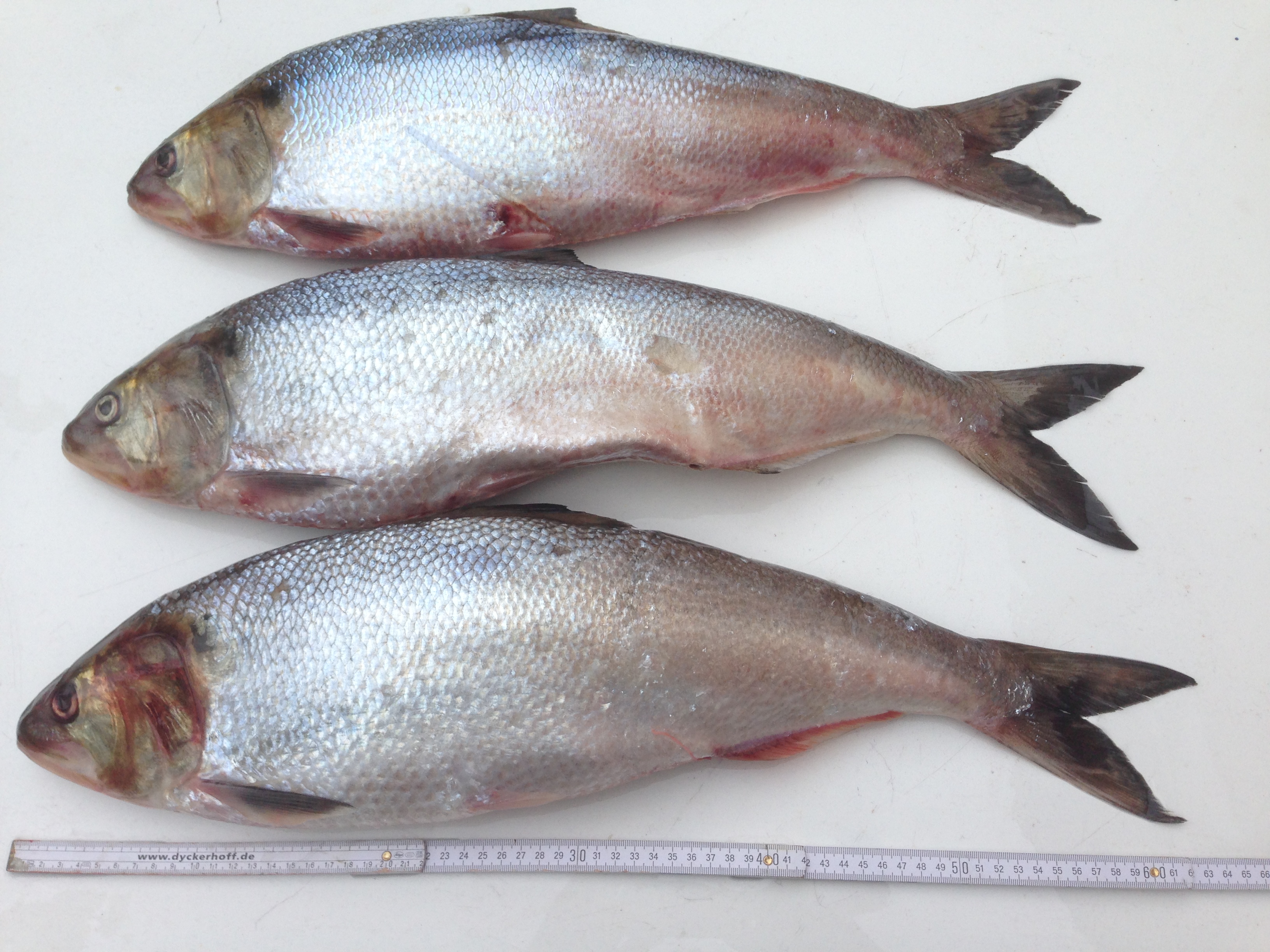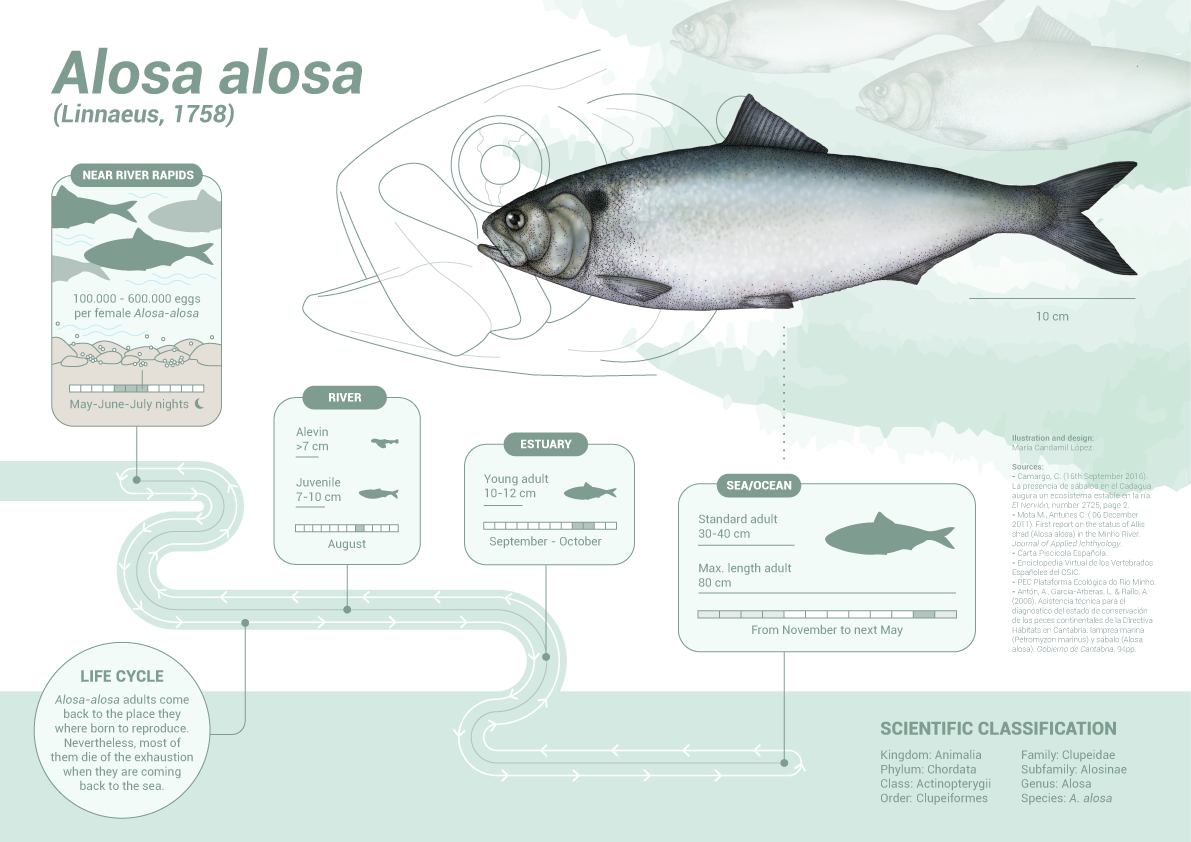Alosa alosa on:
[Wikipedia]
[Google]
[Amazon]
 The allis shad (''Alosa alosa'') is a widespread Northeast Atlantic species of
The allis shad (''Alosa alosa'') is a widespread Northeast Atlantic species of
 ''Alosa alosa'' has a similar lifecycle to that of the
''Alosa alosa'' has a similar lifecycle to that of the
EU LIFE-Project: The re-introduction of allis shad (''Alosa alosa'') in the Rhine system
* {{Authority control
fish
Fish are aquatic, craniate, gill-bearing animals that lack limbs with digits. Included in this definition are the living hagfish, lampreys, and cartilaginous and bony fish as well as various extinct related groups. Approximately 95% of ...
in the herring family, Clupeidae. It is an anadromous fish which migrates into fresh water to spawn. It is found in the eastern Atlantic Ocean, the western Baltic Sea and the western Mediterranean Sea. In appearance it resembles an Atlantic herring but has a distinctive dark spot behind the gill cover and sometimes a row of up to six spots behind this. It sometimes hybridises with the twait shad
The twait shad or twaite shad (''Alosa fallax'') is a species of fish in the family Clupeidae. It is found in the eastern Atlantic Ocean and the Mediterranean Sea and is an anadromous fish which lives in the sea but migrates into fresh water to s ...
(''A. fallax''). This fish becomes mature when three or more years old and migrates to estuaries, later swimming up rivers to spawn. Populations of this fish have declined due to overfishing, pollution and habitat destruction
Habitat destruction (also termed habitat loss and habitat reduction) is the process by which a natural habitat becomes incapable of supporting its native species. The organisms that previously inhabited the site are displaced or dead, thereby ...
. Conservation of this species is covered by Appendix III of the Bern Convention and Appendix II and V of the European Community Habitats Directive.
Description
The allis shad is a typical herring-type fish. It has no lateral line and a somewhat rounded belly. Thegill cover
The operculum is a series of bones found in bony fish and chimaeras that serves as a facial support structure and a protective covering for the gills; it is also used for respiration and feeding.
Anatomy
The opercular series contains four bon ...
is ridged and the scales
Scale or scales may refer to:
Mathematics
* Scale (descriptive set theory), an object defined on a set of points
* Scale (ratio), the ratio of a linear dimension of a model to the corresponding dimension of the original
* Scale factor, a number w ...
large. The back is a bluish-green colour and the head brownish with a golden tinge on the operculum. The flanks are silvery, sometimes with a bronzy tinge, and a distinctive large dark spot occurs just behind the gill cover, and occasionally one to six smaller spots behind that. The adult length is typically .
Distribution
The allis shad is found in the eastern Atlantic in waters bordering most ofEurope
Europe is a large peninsula conventionally considered a continent in its own right because of its great physical size and the weight of its history and traditions. Europe is also considered a subcontinent of Eurasia and it is located entirel ...
and northwestern Africa
Africa is the world's second-largest and second-most populous continent, after Asia in both cases. At about 30.3 million km2 (11.7 million square miles) including adjacent islands, it covers 6% of Earth's total surface area ...
, and it enters to the western Baltic
Baltic may refer to:
Peoples and languages
* Baltic languages, a subfamily of Indo-European languages, including Lithuanian, Latvian and extinct Old Prussian
*Balts (or Baltic peoples), ethnic groups speaking the Baltic languages and/or originati ...
and western Mediterranean
The Mediterranean Sea is a sea connected to the Atlantic Ocean, surrounded by the Mediterranean Basin and almost completely enclosed by land: on the north by Western Europe, Western and Southern Europe and Anatolia, on the south by North Africa ...
Seas, but it is rare outside France
France (), officially the French Republic ( ), is a country primarily located in Western Europe. It also comprises of overseas regions and territories in the Americas and the Atlantic, Pacific and Indian Oceans. Its metropolitan area ...
.
Biology and lifecycle
 ''Alosa alosa'' has a similar lifecycle to that of the
''Alosa alosa'' has a similar lifecycle to that of the twait shad
The twait shad or twaite shad (''Alosa fallax'') is a species of fish in the family Clupeidae. It is found in the eastern Atlantic Ocean and the Mediterranean Sea and is an anadromous fish which lives in the sea but migrates into fresh water to s ...
''A. fallax''. They are known to live in sympatry,Lochet, A., S. Boutry, and E. Rochard. ''Estuarine Phase during Seaward Migration for Allis Shad Alosa Alosa and Twaite Shad Alosa Fallax Future Spawners.'' Ecology of Freshwater Fish 18 (2009): 323-35. and the two species can hybridize. They are anadromous species like many other species in the genus ''Alosa''.Coscia, I., V. Rountree, J. J. King, W. K. Roche, and S. Mariani. ''A Highly Permeable Species Boundary between Two Anadromous Fishes.'' Journal of Fish Biology 77.5 (2010): 1137-149. However, some record of them being landlocked suggests an ability to adapt well to their environment.
They primarily live at sea on feeding grounds and migrate to their spawning grounds between April and June once they are sexually mature. Maturity usually ranges from 3–7 years of age. ''A. alosa'' can usually only reproduce once in their lifetimes. Juveniles appear in estuaries
An estuary is a partially enclosed coastal body of brackish water with one or more rivers or streams flowing into it, and with a free connection to the open sea. Estuaries form a transition zone between river environments and maritime environmen ...
and brackish water around July to August. The salinity of brackish water may pose problems to the juveniles migrating from fresh water.
Population reduction
Populations have been reduced primarily by overfishing, pollution, and habitat destruction. The estuarine phase, or the time that they are in the estuaries migrating from spawning grounds to sea, is estimated to have a duration in ''A. alosa'' of up to six months. The estimate, however, does not take into account individual variation and/or survival of juveniles in the estuarine phase.Conservation
Four special areas of conservation have been designated in Ireland where ''Alosa'' species have been known to spawn. ''Alosa alosa'' "has been placed in Appendix III of the Bern Convention (1979) that lists protected fauna species as well as in Appendix II and V of the European Community Habitats Directive (1992) that list, respectively, species whose conservation requires the designation of special areas of conservation and that are subject to management measures." However, ''A. alosa'' is currently under a moratorium (2008) in numerous French watersheds.References
External links
*EU LIFE-Project: The re-introduction of allis shad (''Alosa alosa'') in the Rhine system
* {{Authority control
allis shad
The allis shad (''Alosa alosa'') is a widespread Northeast Atlantic species of fish in the herring family, Clupeidae. It is an anadromous fish which migrates into fresh water to spawn. It is found in the eastern Atlantic Ocean, the western Bal ...
Fauna of France
Marine fish of Europe
allis shad
The allis shad (''Alosa alosa'') is a widespread Northeast Atlantic species of fish in the herring family, Clupeidae. It is an anadromous fish which migrates into fresh water to spawn. It is found in the eastern Atlantic Ocean, the western Bal ...
allis shad
The allis shad (''Alosa alosa'') is a widespread Northeast Atlantic species of fish in the herring family, Clupeidae. It is an anadromous fish which migrates into fresh water to spawn. It is found in the eastern Atlantic Ocean, the western Bal ...
Least concern biota of Europe
Taxonomy articles created by Polbot